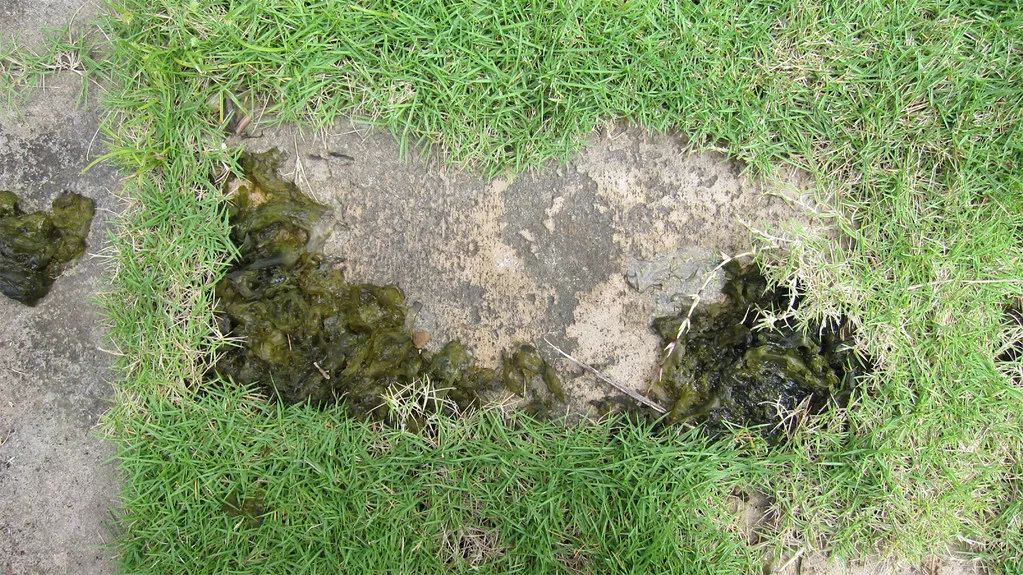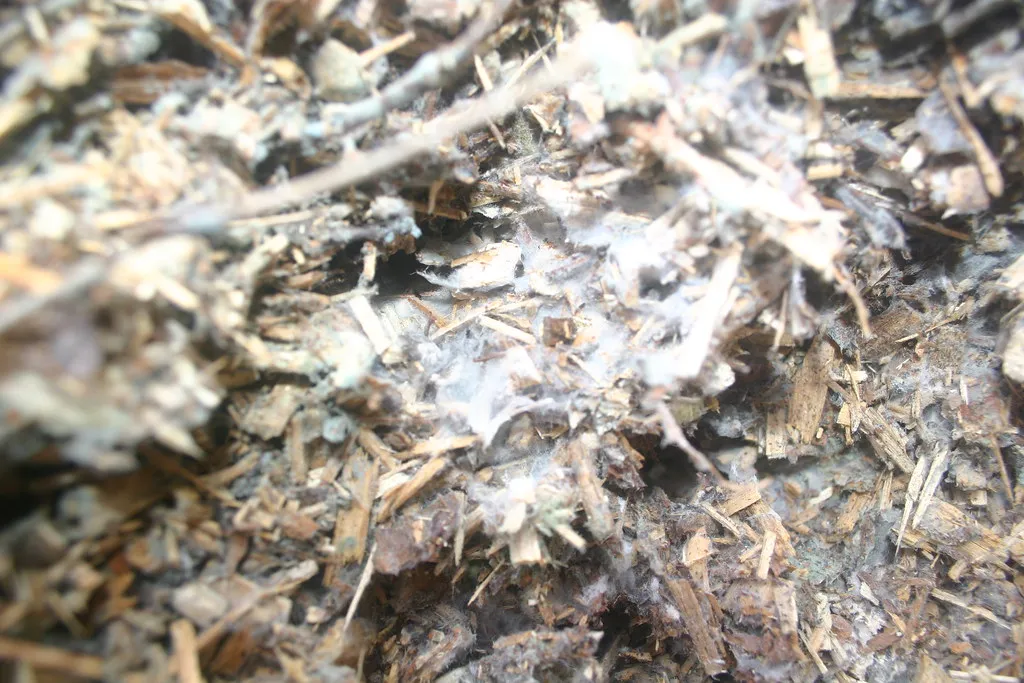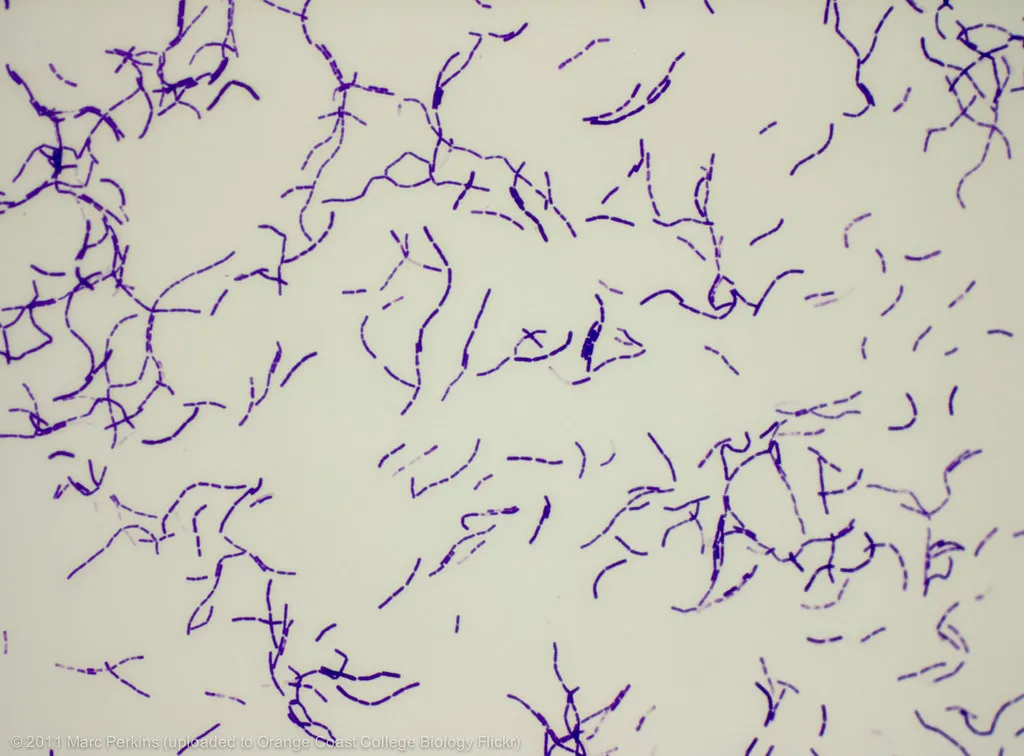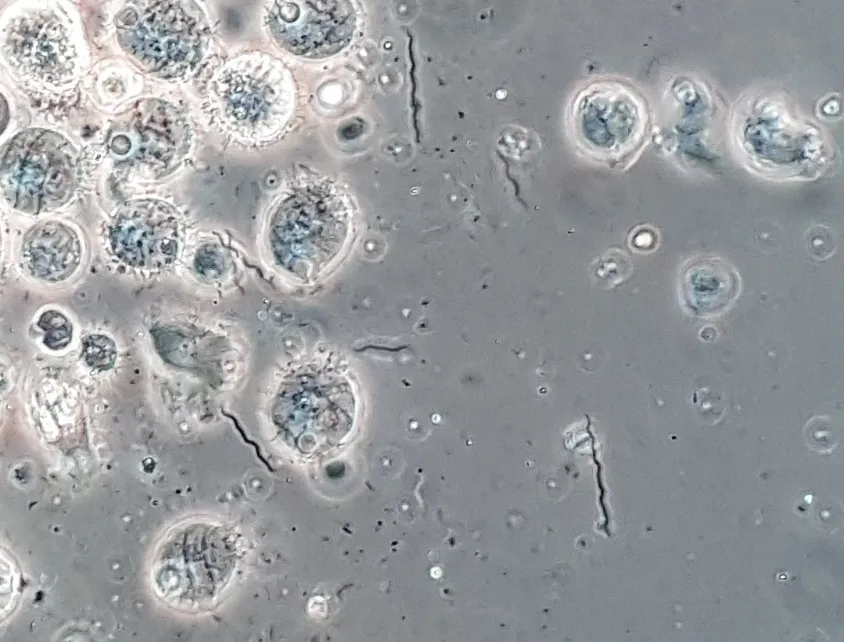Eubacteria, also known as “true” bacteria, are unicellular prokaryotic microorganisms with diverse characteristics, thriving in various environments worldwide. This classification contains all types of bacteria except for archaebacteria.
What are Eubacteria?
Eubacteria, often called “bacteria,” are minute organisms that are invisible to the naked eye. Therefore, microscopes are used to observe and analyze their morphology.
Staining plays an essential role in microbiology as it enables the visualization of bacteria’s complete structure and cellular shape. Gram staining is the classification method distinguishing between gram-negative and gram-positive bacteria.
Eubacteria, being widespread, form an integral part of the three fundamental domains of life, known explicitly as Bacteria.
In the domain of prokaryotic organisms, there are two primary divisions: Eubacteria and Archaebacteria. Eubacteria reside within the Bacteria domain, whereas archaebacteria belong to the Archaebacteria domain.
Eubacteria possess the typical characteristics of prokaryotes while also exhibiting the ability to generate spores, making them capable of causing diseases in humans and animals.
Reproduction in eubacteria occurs through binary fission or budding, often forming large colonies that can create unique extracellular structures called “biofilms,” which serve as protective shields for the colony.
Characteristics of Eubacteria
Cell Structure
Eubacteria are single-celled organisms that lack a true nucleus and membrane-bound organelles. They are characterized by their simple cellular structure, consisting of a cell wall, cell membrane, and a circular chromosome containing their genetic material.
Certain bacteria possess a flagellum, a protein filament-based structure enabling movement. In contrast, other bacteria feature pili, small projections covering the cell’s exterior that aid in adhering to surfaces and facilitating DNA transfer.

Eubacteria reproduce through binary fission, a process in which a single cell divides into two identical daughter cells. This rapid reproduction allows them to colonize new habitats quickly and adapt to changing environmental conditions.
They can also transfer genetic material through horizontal gene transfer, enabling them to acquire beneficial traits from other bacteria.

In addition to the circular DNA within bacteria, plasmids exist as separate entities. Also known as “replicons,” plasmids are self-replicating DNA molecules. These compact DNA rings enable bacteria to transfer genes between organisms.
Bacteria can acquire new genes and traits through horizontal gene transfer, including antibiotic resistance. Plasmids play a vital role in facilitating rapid adaptation to changing environmental conditions by promoting mutation in bacteria.
Plasmids can be transmitted to daughter cells like other genetic material during replication.
Metabolism
Eubacteria exhibit diverse metabolic methods. They can be autotrophic, obtaining energy from sunlight through photosynthesis, or heterotrophic, obtaining energy by consuming organic matter.
Some eubacteria are capable of chemosynthesis, utilizing inorganic compounds to produce energy. This metabolic versatility contributes to their success in various environments.
Ecological Importance
Eubacteria inhabit essential positions in ecological processes, fulfilling vital roles. They play an important part in nutrient cycling, breaking down organic matter and releasing essential elements like carbon, nitrogen, and phosphorus back into the ecosystem.
Moreover, eubacteria contribute to the equilibrium of ecosystems through their interactions with various organisms, including plants, animals, and other microbes.
Classification of Eubacteria
Eubacteria are classified into different kingdoms and phyla based on their genetic and physiological characteristics. The two main kingdoms of eubacteria are the Archaebacteria and the Eubacteria.
Archaebacteria are recognized for their exceptional capacity to live in extreme environments, while eubacteria include the predominant prokaryotic organisms in various habitats.
The kingdom Eubacteria is subdivided into multiple phyla, each representing a unique lineage of bacteria. Some of the significant phyla include the Cyanobacteria, Chlorobi, Chloroflexi, Actinobacteria, Proteobacteria, Firmicutes, Planctomycetes, and Spirochaetes.
- Proteobacteria: This phylum comprises the majority of gram-negative bacteria and is believed to have evolved from photosynthetic ancestors. Proteobacteria are further classified into five classes: alphaproteobacteria, beta proteobacteria, gammaproteobacteria, deltaproteobacteria, and epsilon-proteobacteria.
- Cyanobacteria: These bacteria possess a blue-green pigment and engage in photosynthesis, much like plants and algae. Many cyanobacteria play a crucial role in agriculture as they can fix nitrogen in the soil.
- Chlorobi: Within this phylum, one finds photosynthetic green sulfur bacteria. Chlorobi uses organic compounds like carbohydrates and acids to reduce carbon dioxide during photosynthesis. The members of this phylum exhibit diverse forms, including rods, spirals, cocci, or budding structures.
- Chloroflexi: Chloroflexi members, also called green nonsulfur bacteria, are capable of photosynthesis. 5. Chlamydiae: This phylum comprises pathogenic gram-negative cocci with a unique developmental cycle. Chlamydiae can be transmitted through direct contact or respiratory airborne routes between humans.
- Planctomycetes: These budding gram-negative bacteria possess DNA similar to bacteria but possess cell walls resembling those of archaea. Some Planctomycetes even contain organelles reminiscent of eukaryotes.
- Bacteroidetes: Anaerobic bacteria in the Bacteroidetes phylum are commonly found in the human intestinal tract, oral cavity, and feces. They may cause infections from surgical procedures or puncture wounds in some instances.
- Fusobacteria: Anaerobic bacteria, often pleomorphic or spindle-shaped, fall under the Fusobacteria category.
- Spirochaetes: These bacteria exhibit a distinctive coiled shape, resembling tightly wound metal springs. Flagellated, they utilize axial filaments in their movement. Spirochaetes are typically present in the human oral cavity.
Difference between Eubacteria and Archaebacteria
Archaebacteria and Eubacteria, although both prokaryotic, reside in distinct biological domains due to their significant genetic variation. Archaebacteria are considered some of the oldest life forms on Earth, whereas Eubacteria emerged later in evolutionary history.
Eubacteria have colonized nearly every environment, whereas archaebacteria have been constrained to only the most extreme habitats, such as high-salinity lakes, thermal hot springs, and the deep recesses of the Earth’s crust.
These groups exhibit several other differences. For instance, archaebacteria are generally impervious to antibiotics, whereas most eubacteria are susceptible unless they have developed resistance.
Archaebacteria typically do not cause human infections or contribute to digestion, thus posing minimal health concerns. Moreover, eubacteria can form spores as a survival mechanism during adverse conditions, whereas archaebacteria lack this capability.
Table: Key differences between archaebacteria and eubacteria
| Characteristic | Archaebacteria | Eubacteria |
|---|---|---|
| Cell Wall Composition | Unique cell wall composition | Peptidoglycan cell wall |
| Plasma Membrane Lipids | Ether-linked lipids | Ester-linked lipids |
| DNA Replication | Unique DNA replication machinery | Similar DNA replication to eukaryotes |
| Metabolic Diversity | Can survive in extreme environments | Wide range of metabolic strategies |
| Oxygen Requirement | Some can be anaerobic | Varied oxygen requirements |
| Habitat | Extremophiles (e.g., hot springs, salt flats) | Diverse habitats (soil, water, human body) |
| Sensitivity to Antibiotics | Often resistant to many antibiotics | Variable sensitivity to antibiotics |
| Genetic Relatedness | Genes show similarities to bacteria | Genes show similarity to bacteria |
Examples of Eubacteria
Cyanobacteria
Cyanobacteria, commonly called blue-green algae, belong to a species of eubacteria known for their photosynthetic abilities. These unique organisms profoundly impact the Earth’s atmosphere, as billions of years ago, they were responsible for generating oxygen through photosynthesis.

Cyanobacteria can be found in various environments, ranging from freshwater and marine habitats to terrestrial ecosystems.
Actinobacteria
Actinobacteria are a diverse group of bacteria known for their filamentous growth and ability to produce a wide range of compounds. They can be found in various environments, including soil, water, and human skin.

These bacteria have attracted significant attention from researchers and industries due to their potential for producing antibiotics, anticancer drugs, and enzymes.
Proteobacteria
Proteobacteria comprise the largest and most diverse phylum of eubacteria. They are commonly found in soil, water, and the gastrointestinal tracts of animals.
Proteobacteria include many pathogenic species, such as Escherichia coli and Salmonella, and beneficial bacteria, like Rhizobium, which form symbiotic relationships with leguminous plants and fix nitrogen from the atmosphere.
Firmicutes
The term “Firmicutes” originated from Latin, specifically from the words describing “tough skin,” which aptly characterizes the thick cell wall commonly found in bacteria in this phylum. Initially, scientists encompassed all gram-positive bacteria within the classification of Firmicutes.
However, recent advancements have led to a refined definition, identifying them as a distinct core group, the low-G+C group, distinguished from the Actinomycetota.

These bacteria typically possess spherical cells, called cocci (singular: coccus), or elongated forms resembling rods (bacillus). Some members of the Firmicutes family, including Megasphaera, Pectinatus, Selenomonas, and Zymophilus, exhibit a unique porous pseudo-outer membrane, resulting in their ability to stain gram-negative.
Spirochaetes
Spirochaetes stand out among other bacterial phyla due to the unique positioning of their flagella, known as endo flagella or axial filaments. Unlike external flagella, these endo flagella are anchored at both ends of the bacterium within the periplasmic space between the inner and outer membranes.

Remarkably, they extend backward, effectively elongating the cell and enabling a twisting motion that facilitates the spirochaete’s movement. During reproduction, spirochaetes undergo asexual transverse binary fission. While most spirochaetes are anaerobic and free-living, exceptions to this rule exist in abundance.
Evolution of Eubacteria
Prokaryotic cells encompass the simplest forms of bacteria and blue-green algae, also known as cyanobacteria. These cells lack a nuclear membrane that separates the genetic material (DNA) from the cytoplasmic components and do not possess introns.
From a phylogenetic perspective, the progenote eventually gave rise to three distinct cell types: Archaebacteria, Eubacteria, and eukaryotes. Molecular theories propose the horizontal transfer of genes between these cell types, significantly influencing the evolutionary trajectory of life.

According to the endosymbiotic theory, mitochondria and chloroplasts were genetically transmitted through gene transfer during the evolutionary journey of certain bacteria.
Eubacteria encompass a diverse range of organisms, including Cyanobacteria, Chloroxybacteria, Paracoccus, Non-sulphur bacteria, sulfur bacteria, green filamentous bacteria, green sulfur bacteria, Spirochetes, and Desulphovibrio.
Role of Eubacteria in the Environment
Nitrogen Fixation
Certain eubacteria, such as those in the Rhizobium genus, can fix atmospheric nitrogen into a form that plants can use.
Through symbiotic relationships with leguminous plants, these bacteria reside in specialized structures called nodules on plant roots and convert atmospheric nitrogen into ammonia, providing an essential nutrient source for the plant.
Decomposition
As highly important decomposers, Eubacteria play a fundamental role in the complex web of ecosystems. Their primary function revolves around the breakdown of complex organic matter and transforming it into simpler compounds.
In this important decomposition process, eubacteria efficiently recycle essential nutrients. They diligently break down the remnants of deceased plants, animals, and other organic materials, releasing the trapped nutrients into the environment.
As a result, these vital nutrients become readily available for uptake and utilization by other organisms, ensuring the sustainability and balance of the ecosystem as a whole.
Symbiotic Relationships
Eubacteria form symbiotic associations with a diverse range of organisms, showing the interconnectedness of the microbial world. An ideal example of such symbiosis is the mutualistic relationship between specific bacteria residing in the termite gut and termites themselves.
These bacteria play a crucial role in the digestion of cellulose, allowing termites to extract energy from their diet efficiently. Similarly, in the rumen of cows, certain bacteria contribute to the breakdown of cellulose found in plant material, aiding digestion.
These fascinating symbiotic partnerships highlight the complex interdependencies between eubacteria and other life forms, highlighting nature’s complex and essential connections.
Importance of Eubacteria in Human Health
Gut Microbiome
The human gastrointestinal tract is a unique ecosystem with abundant, diverse bacteria, among which numerous eubacteria live. Collectively referred to as the gut microbiome, this vast community of bacteria is essential in shaping and maintaining human health.
Beyond their key involvement in digestion, these microorganisms go above and beyond by actively working in multifaceted functions, including synthesizing vital vitamins and regulating the immune system. It is essential to recognize disquiet in the delicate equilibrium of the gut microbiome.
Pathogenic Bacteria
Numerous eubacteria are helpful, but some can harm people by spreading disease. Staphylococcus, Escherichia coli, and other pathogenic bacteria have developed defenses against the immune system to infect people.
Developing efficient therapies and preventive measures requires thoroughly understanding the pathogenic bacteria’s processes.
Eubacteria in Industry and Biotechnology
Antibiotic Production
Eubacteria or their metabolites are the source of several antibiotics, including penicillin and tetracycline. These antibiotics have changed medicine and saved many lives by preventing bacterial infections.
Ongoing research tries to find novel antibiotic molecules from eubacteria to combat the rising worry of antibiotic resistance.
Bioremediation
Bioremediation, the technique of using living organisms to eliminate contaminants from the environment, depends heavily on eubacteria. Some bacteria can transform hazardous materials, such as industrial waste or oil spills, into benign byproducts.
An environmentally acceptable method of cleaning up contaminated locations is to use eubacteria in bioremediation.
Food Production
Eubacteria also used in the food industry for several purposes. Fermentation foods with Lactobacillus and Streptococcus bacteria produce fermented foods like yogurt, cheese, and sauerkraut.
These bacteria aid flavor development, product preservation, and nutritional value enhancement.
Key Points
- Eubacteria, sometimes called “true” bacteria, are unicellular prokaryotic microorganisms worldwide.
- Microscopes and staining procedures are used to observe and analyze Eubacteria structure.
- Eubacteria possess simple cellular structures, including cell walls, membranes, and circular chromosomes.
- They can reproduce through binary fission or budding and form colonies and biofilms.
- Eubacteria exhibit diverse metabolic methods, including autotrophy, heterotrophy, and chemosynthesis.
- They play vital roles in nutrient cycling and ecological equilibrium, interacting with other organisms.
- Eubacteria are classified into kingdoms (Archaebacteria and Eubacteria) and phyla (e.g., Cyanobacteria, Proteobacteria, Firmicutes).
- Eubacteria and Archaebacteria differ in genetic variation, habitats, antibiotic resistance, and other characteristics.
- Examples of eubacteria include Cyanobacteria, Actinobacteria, Proteobacteria, Firmicutes, and Spirochaetes.
- Eubacteria contribute to nitrogen fixation, decomposition, symbiotic relationships, human health, and biotechnology applications in industries.
- They are used in antibiotics, bioremediation, and food production (fermentation).
FAQs
While some eubacteria can cause diseases, others are harmless or beneficial to human health.
Some eubacteria, particularly those in the kingdom Archaebacteria, are known for their ability to thrive in extreme environments such as hot springs and salt flats.
Eubacteria decompose organic matter, releasing nutrients into the environment, which other organisms can utilize.
The gut microbiome, including eubacteria, plays a crucial role in digestion, modulation of the immune system, and overall human health.
Eubacteria are utilized in various biotechnological processes, including the production of antibiotics, bioremediation of pollutants, and the fermentation of food products.
References and Sources
- Verma, P. S., & Agrawal, V. K. (2006). Cell Biology, Genetics, Molecular Biology, Evolution & Ecology (1 ed.). S . Chand and Company Ltd.
- Whitfield, C., Szymanski, C. M., Lewis, A. L., & Aebi, M. (2022). Eubacteria. Essentials of Glycobiology [Internet]. 4th edition.
- Iwabe, N., Kuma, K. I., Hasegawa, M., Osawa, S., & Miyata, T. (1989). Evolutionary relationship of archaebacteria, eubacteria, and eukaryotes inferred from phylogenetic trees of duplicated genes. Proceedings of the National Academy of Sciences, 86(23), 9355-9359.
- Levin, S. A. (2013). Encyclopedia of biodiversity. Elsevier Inc.
- Ochman, H., & Wilson, A. C. (1987). Evolution in bacteria: evidence for a universal substitution rate in cellular genomes. Journal of molecular evolution, 26(1-2), 74-86.
- Tortora, G. J., Funke, B. R., & Case, C. L. (2015). Microbiology: An Introduction, Global Edition. USA: Pearson Education.
- Whitfield, C., Szymanski, C. M., & Aebi, M. (2017). Eubacteria. In Essentials of Glycobiology [Internet]. 3rd edition. Cold Spring Harbor Laboratory Press.
- https://biologydictionary.net/eubacteria/
- https://www.biologyonline.com/dictionary/eubacteria
- https://en.wikipedia.org/wiki/Bacillota
- https://en.wikipedia.org/wiki/Spirochaete
- https://en.wikipedia.org/wiki/Eubacterium
